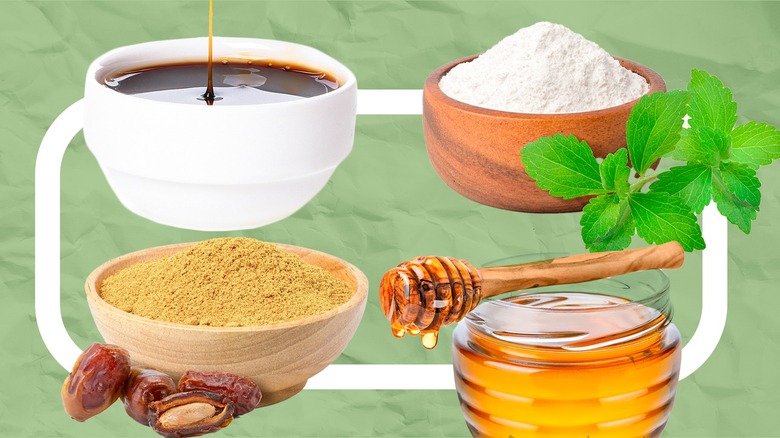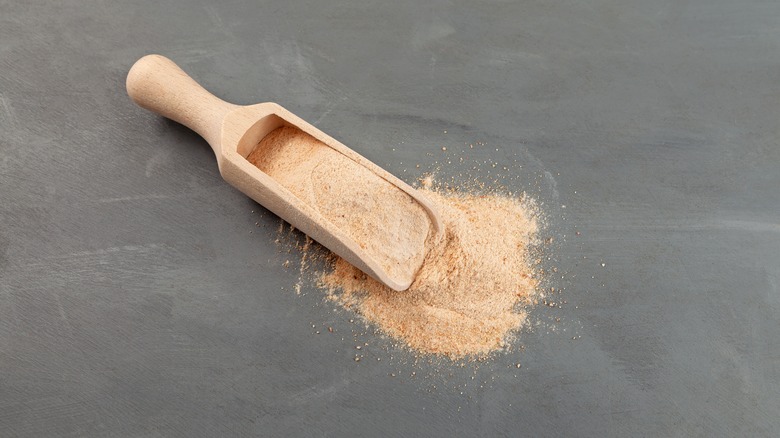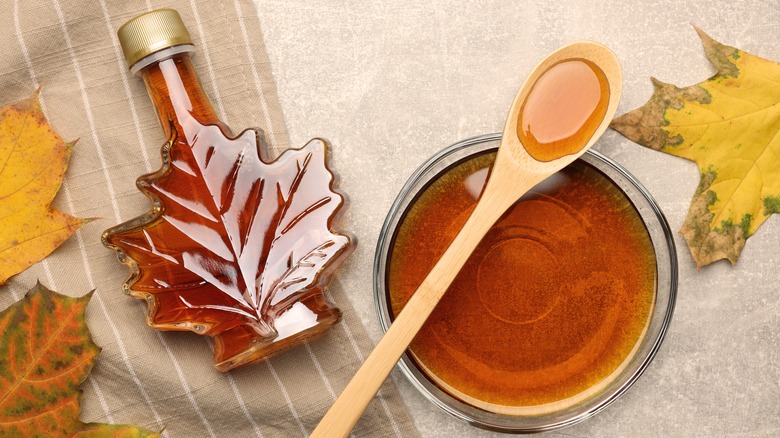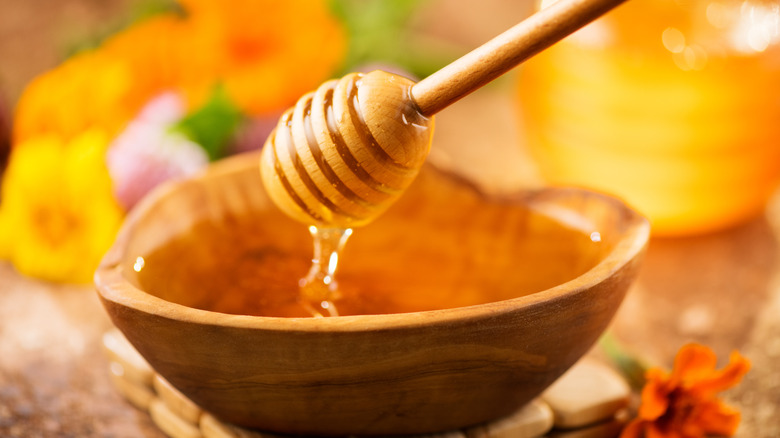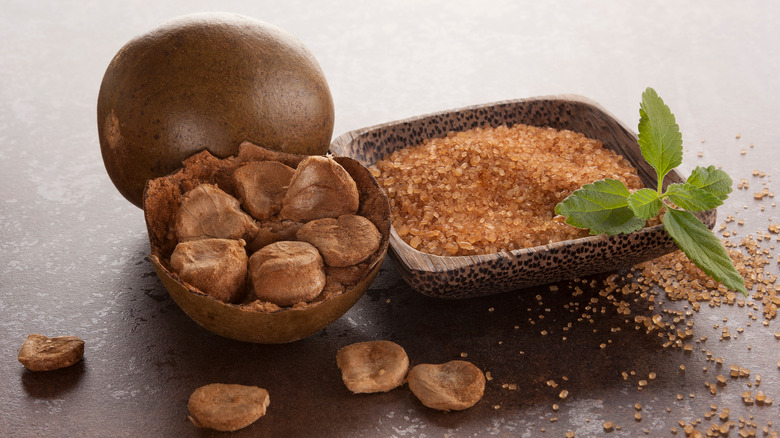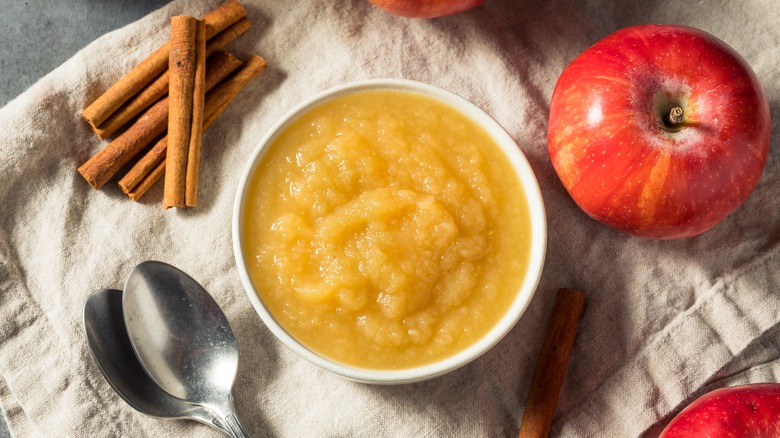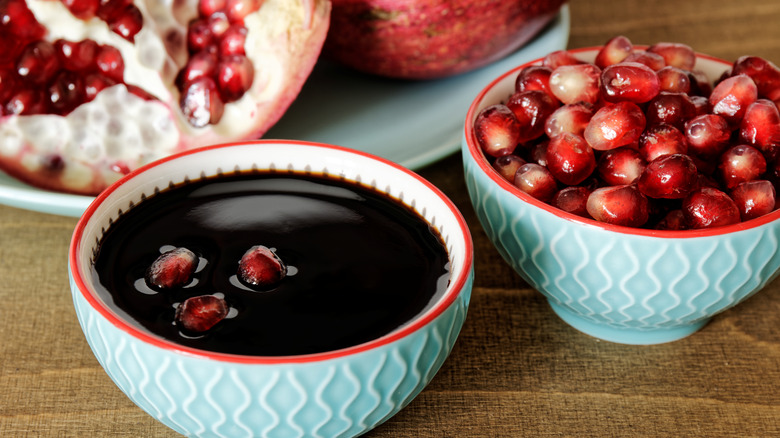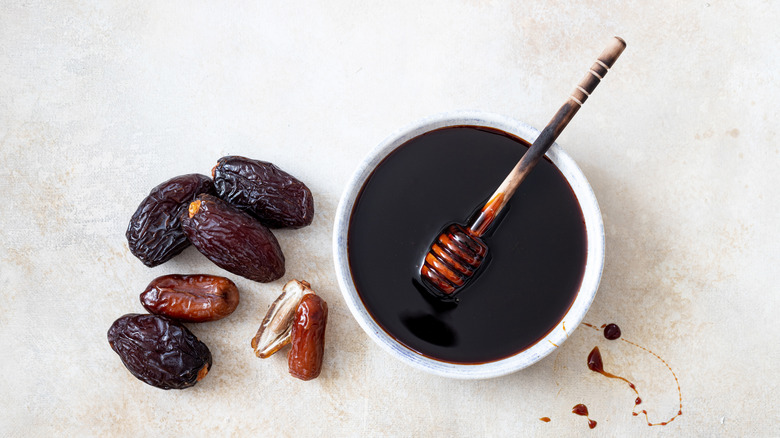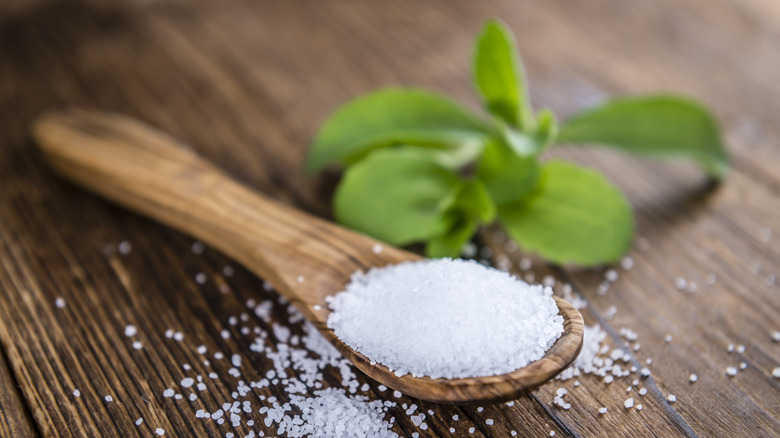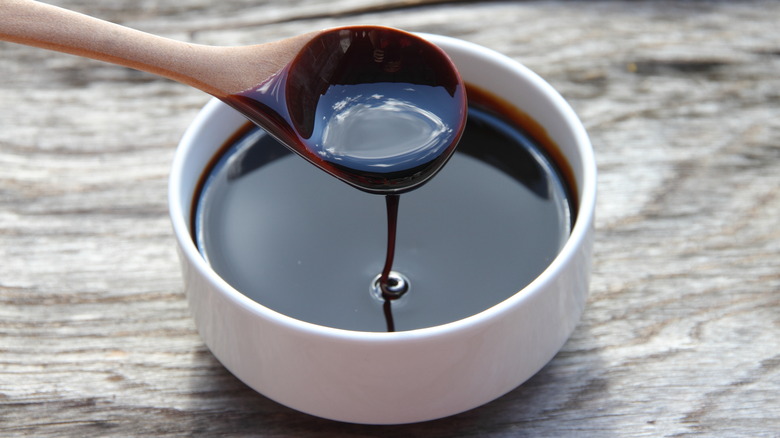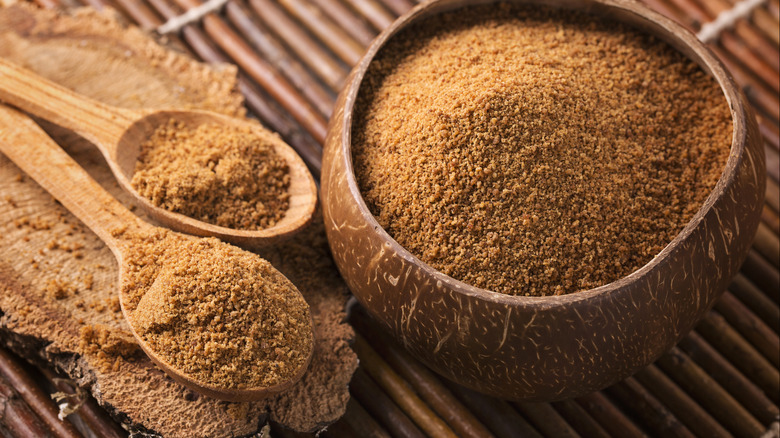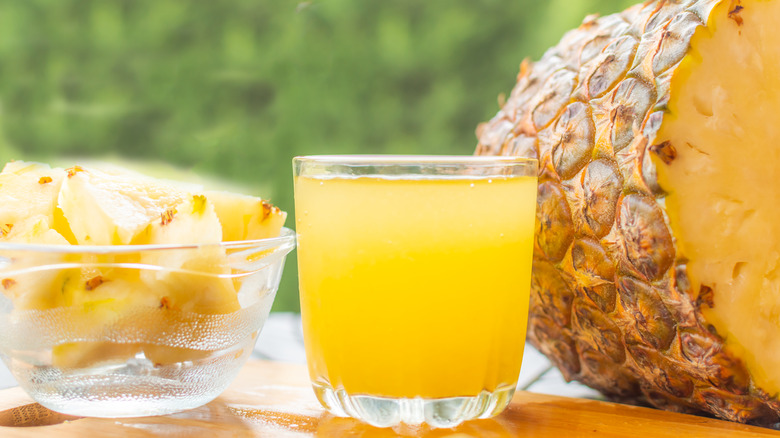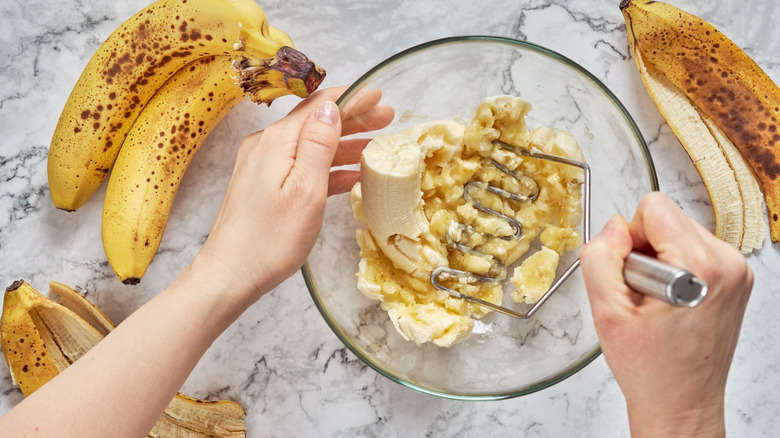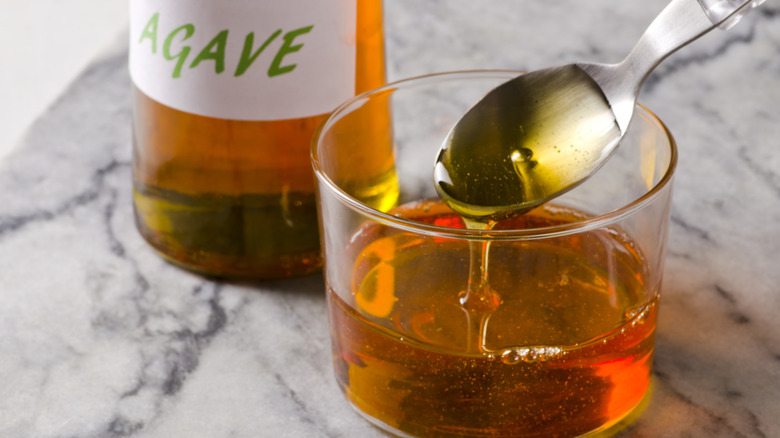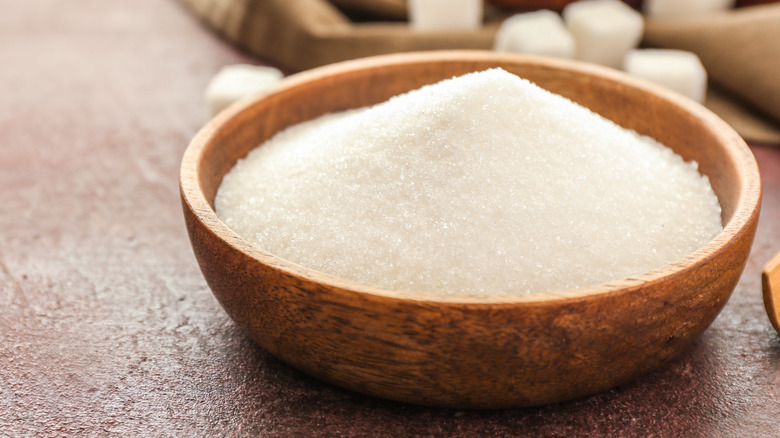14 Best Sweeteners For Cooking That Aren't Sugar
To go from home cook to culinary master, you need innovation and creativity. Stray from the norm and add your own flair. For instance, vinegar adds acidity, and salt adds saltiness, but in reality, the ingredient options to achieve a similar goal with layered depths of flavor are endless. When it comes to sweetening recipes, yes, you could use plain old white sugar and it would do just fine. Your food would be sweeter without you having to think twice. But if you want to add the perfect sweetener to match your dish's style, then you'll have to do a little more digging than just reaching for the sugar jar. There are plenty of sweeteners for cooking that aren't sugar out there, and it's time you expanded your palate.
For instance, when making a fresh lime vinaigrette from scratch, you need some kind of sweetener to balance the acidity of the citrus. While you could spring for a spoonful of sugar and it would do the trick, wouldn't a richer, more floral sweetener elevate the overall taste? In this case, honey would not only boost the sweetness of the mixture but add additional layers of depth. And that's just one example. Let's explore the best sweeteners to use in your cooking that aren't sugar.
Date sugar
When it comes to a healthy diet, there's no dispute that cooking with and consuming whole foods is the way to go. Sugar is typically extracted from sugar cane or beets and is therefore not a whole food. The sucrose is separated from the fiber of the plant, which would otherwise help in aiding the slow release of glucose into the bloodstream preventing spiking and crashing. In addition, the nutrients from the whole plant are also discarded, leaving nothing but the sugar behind. If you're looking for a whole-foods alternative to sugar, look no further than date sugar.
Date sugar is simply made of dehydrated, whole dates that resemble light brown sugar. Because dates are incredibly sweet, there is plenty of natural sugar to go around. The flavor is similar to that of molasses, brown sugar, and even a little caramel for some palates. You can purchase date sugar at the grocery store in the baking section or the health food aisle. It's slightly less sweet than cane sugar, so feel free to use more of it in your cooking. It's a sweetener you can feel truly good about. Besides the reduced water content, you are essentially eating dates, which are a healthy fruit.
Maple syrup
New Englanders put maple syrup on everything. And why we say everything, we mean it. Up in the Northeast, where folks carry kitty litter in the trunks of their cars for icy days and call springtime "mud season", there's an elite sweetener that dominates the sugar scene. Maple syrup is made from tapped sugar maple trees that freeze and thaw in late fall and early spring. This change in temperature liquefies the sap, and the trees are tapped to collect the stuff. This sap resembles sugar water and must be boiled until the water content evaporates, leaving behind a sticky, sweet, flavorful syrup. There are plenty of unconventional ways to use maple syrup in the kitchen including using it in coffee, pouring it over bacon, adding it to baked salmon, drizzling it on steamed carrots, and adding it to pretty much any dessert you can think of. Maple syrup can be used in sauces, dressings, and marinades and is a fantastic sweetener to replace sugar in any scenario. It's nutrient-dense and has much more flavor than your typical white sugar.
Maple syrup has a smoky, oaky flavor mixed with a caramel-like or vanilla sweetness. Any true New Englander or Canadian can distinguish maple syrup from artificial pancake syrup by smell and look alone. Its flavor is unmatched, and it deserves a place in any recipe, sweet or savory.
Honey
Honey is one of the only animal-made sweeteners out there that people regularly use. And while most people are aware that honey comes from bees, they could probably never guess what honey is actually made out of. The process starts when worker bees collect nectar from plants using their tongues and store it in their stomachs. A chemical process occurs in their bodies that reduces the water content of the nectar. The enzymes in their systems turn the complex sugar into simple sugar before they regurgitate it up and store it in honeycombs for later use. This honey is used to help feed the bees over winter, and the process of turning nectar into honey keeps the nectar from fermenting over periods of time, as it is antibacterial. Each bee can produce a tablespoon of honey in its lifetime, so as you can see, each drop takes an incredible amount of effort to make.
Honey has an earthy, floral, fruity flavor that can leave a subtle aftertaste. It's incredibly sweet and is often stirred into tea, drizzled over toast or baked goods, and paired with citrus. Although it can be quite expensive, it does make a delicious ingredient in just about any dish that requires sugar. Outside of drinks and baking, it's best used in roasting vegetables and grill marinades. Or you can whisk it with lemon for an easy, sweet dressing, or drizzle it onto soft cheeses to accentuate their flavors.
Monk fruit
As people move further and further away from refined sugars and artificial sweeteners, monk fruit has made its way onto the scene as a popular alternative. Because it's new to the average consumer (at least for the west) there's plenty you still need to know about monk fruit sweetener. This sweetener is much more powerful than standard sugar, and believe it or not, comes from the juice of a high-antioxidant gourd. It's been used traditionally in China for centuries but has been increasing in popularity in the U.S. as consumers become more aware of the ingredients in their processed foods and the effects of refined sugar on the body.
In comparison to sugar, monk fruit has a subtle fruity flavor and a slight aftertaste. This alternative sweetener can be used raw just like sugar to sweeten drinks, fruits, or hot cereal. It's also used in baking and cooking of all kinds. Do not use a 1:1 ratio to replace sugar in a recipe, because monk fruit is incredibly powerful and extremely sweet. Depending on the brand and kind of monk fruit sweeter you purchase, its levels of flavor and sweetness may vary. Read the back of the bag if using it as a sugar replacer, and before you dump a teaspoon in your coffee or tea, give it a little try.
Applesauce
When it comes to America's favorite sweet fruit treat, apples come in on top. They're sweet and portable, and rumor has it, they even keep the doctor away. Applesauce — simply the cooked version of apples — tastes even sweeter and can come in handy when baking for more than one reason. Applesauce is not only a healthy, whole-food way to sweeten baked goods, but also comes in handy as a vegan egg replacer. It helps the batter bind together and replaces the moisture ratio of eggs beautifully. Because one apple typically has about 19 grams of natural sugar (and plenty of fiber to level it out), the addition of applesauce to any batter can sweeten it right up.
Besides applesauce, apple juice can be used as a liquid sweeter in marinades, sauces, dressings, and desserts. Even sliced-up apples can be added to baked goods and will cook down into little pockets of tangy sweetness.
Pomegranate juice and syrup
Although pomegranates are complicated to de-seed, they are well worth the labor. It seems pomegranates make their appearance every fall as a salad topping and Thanksgiving centerpiece. Other than that, the fruits can be enjoyed as juice or whole fruit, for those who don't mind getting their hands dirty. Pomegranate juice is incredibly rich in antioxidants, which give it its deep dark coloring. It's also very sweet and can be reduced into a pomegranate molasses syrup that's even sweeter than the juice, if you can believe it.
The juice itself is rich like cherry juice and slightly tart like cranberries. It holds a depth like concord grapes and currants but really marches to the beat of its own drum, which makes it so desirable. Pomegranate molasses, on the other hand, has a syrupy texture and is reminiscent of balsamic vinegar reduction because of its sour-sweet duality.
Pomegranate juice is used in cocktails, sauces, and marinades, while pomegranate molasses can be drizzled on just about anything, sweet or savory. It's not unusual to find the syrup on duck, paired with chocolate, mixed into salad dressing, or drizzled on fruit.
Date syrup
While date syrup may sound like date sugar's liquidy friend, the process to make it and the outcome in flavor are quite different. Date syrup is not entirely a whole food, but is pretty darn close to it. It's made by extracting the nectar from dates by boiling them, blending them, pressing the paste through a fine strainer, and then evaporating excess water. This is still an extremely healthy alternative to refined sugar because dates are nutrient-dense, and those nutrients aren't removed during the syrup harvesting process. It's sticky-sweet and thick like honey or molasses and has a rich deep reddish-brown color. Date syrup has undertones of molasses flavors but is also fruity with hints of caramel.
Homemade date syrup, on the other hand, is a whole food typically made by simply blending dates and water together to make a syrup or paste. This version is loaded with healthy fiber that balances out those sugar peaks and crashes and regulates glucose levels. This version of date syrup is not quite as intense, sweet, or rich, but still contains quite a bit of sugar and flavor. To make a healthy caramel syrup, simply add pure vanilla extract and a small pinch of salt to your blended dates and water. Use this healthy caramel alternative in recipes, to top desserts, or in baked goods. Date syrup really should be your go-to alternative sweetener.
Stevia
It's hard to believe that one of the sweetest substances out there comes from a leaf. That's right — not a cane or fruit, but a green leaf. That of the stevia plant to be exact. Powdered stevia is extracted by soaking the sweet leaves in water to leech the sweet-tasting substance. It's then filtered, purified, dried, and eventually crystallized into the form we buy it in. If you've ever purchased the sweeter, then you know it often comes with a teeny tiny spoon. This spoon is to help you measure out the small portion that is needed to sweeten your food because if you used a real spoon, the flavor and sweetness would be overwhelmingly powerful.
Stevia could quickly become the top sugar substitute, not only because it's calorie-free and not linked to the same health hazards as sugar, but because the crop is becoming less expensive. The stevia plant is producing higher yields at a gradual increase, lowering the high price tag that might deter some shoppers. Use it in baked goods, desserts, and other sweet treats.
Molasses
While technically molasses is made from cane sugar or sugar beets, just like white table sugar, it's quite different. When sugar is extracted, it undergoes a process where crushed sugar cane or beets are boiled down to create sugar crystals. The liquid that is leftover and reduced is molasses. Lighter molasses comes from the first time it's boiled down, then dark molasses comes from the second time. Finally, blackstrap molasses, the sweetest, darkest, and stickiest of all, comes from that third reduction.
Molasses is much more nutrient-dense than white granulated sugar and has a much richer flavor as well. Some describe molasses as tasting like sweet, thickened prune juice, while others note caramel and vanilla undertones. It's sharper than honey and carries a slight bitterness that not only can add to the overall flavor of a recipe, but that bitterness also intensifies the darker the molasses becomes.
Use molasses in meat marinades, drizzled over desserts like ice cream or fruit, and as a sugar substitute in baked goods. It's sticky, sweet, and rich in flavor. Keep in mind that it's incredibly thick, so you probably shouldn't refrigerate molasses if you ever plan on getting it out of the bottle.
Coconut sugar
While coconuts might not seem like a top pick for the sweetest fruit around, they contain quite a bit of sugar, and their juice when harvested from young coconuts is loaded with sugar and electrolytes. While you may be picturing coconut sugar coming from the juice or meat, it actually comes from the coconut tree flower. This flower produces a milky sap that is then processed to create coconut sugar. This sap is boiled down, allowing water to evaporate before it turns into a crystalized substance.
Coconut sugar has a brown appearance and a caramel-like deep flavor. (It doesn't taste like coconut.) It can be used in a 1:1 ratio to replace white sugar but should be considered mainly for darker baked goods, sauces, and marinades. Coconut sugar could be ruining your baked goods if you've been adding it to light-colored and delicate sweets like lemon poppy seed cake, angel food cake, or shortbread cookies.
Pineapple juice
When it comes to fruit juice, pineapple takes the cake for sweetness. The juice itself is practically syrup and has a strong sugary flavor with a tiny hint of tangy citrus. There's a reason pineapple upside-down cake is so sticky and sweet. But just as flawlessly as pineapple seems to fit into uber-sweet desserts, it also holds its own in savory dishes alongside pork in fried rice and with jerk-seasoned vegetables.
Although we wouldn't recommend you use pineapple juice to sweeten your coffee, it's certainly delicious in cocktails, baked goods, salad dressings, marinades, and curries. It's the perfect ingredient for your summer meat marinades because pineapple juice makes for a wonderful meat tenderizer. It contains the enzyme bromelain, which breaks down proteins by dissolving collagen fibers. Perhaps that's why your tongue feels so fuzzy after indulging in the fruit. But don't worry, pineapple won't eat you from the inside out. We have a defense mechanism in our saliva that neutralizes the enzyme. Consider pineapple juice as both a sweetener and tenderizer at your next barbecue.
Bananas
Bananas contain about 14 grams of sugar each, so it's no wonder they are super sweet, especially if you've given them a chance to ripen. They also have a subtle flavor and make for a fantastic egg substitute in baked goods when mashed. Try mashing bananas and adding them to your pancakes, french toast, waffles, and muffins. Why should banana bread get all the fun?
If you're transitioning to plant-based milk, or you're having trouble getting your kids to give it a try, blend half a banana into a glass of non-dairy milk to sweeten it up. Don't worry, bananas are packed with fiber and won't give you or your little ones a sugar rush. In addition, frozen bananas can be added to any smoothie to make it ultra-sweet and creamy. Frozen bananas can be blended into a one-ingredient vegan ice cream that is sweet as can be.
Agave
It's hard to believe that agave syrup and tequila come from the same plant. One is syrupy sweet, while the other can twist your face and make your eyes roll back into your skull. Agave syrup is extracted from the core of a desert succulent, the agave plant, which looks like a giant aloe vera plant. Agave is often used as a vegan alternative to honey, as it carries similar notes and has the same consistency and even coloring.
Before adding agave syrup to your morning coffee, keep in mind that it is quite a bite sweeter than table sugar, so you'll likely need less of it. However, it is conveniently liquified, so there will be no need for you to wait until those sugar crystals have dissolved. Agave is also used to sweeten tea and other beverages, including cocktails.
Some choose to drizzle agave on their pancakes, use it in baking, and even make salad dressings or marinades from it. Any recipe that calls for sugar can easily be swapped for agave.
Fig allulose
While monk fruit and agave may seem mainstream to those in the food world, or our earthy crunchy friends, fig allulose is more obscure. Allulose is typically made with figs, but can also come from raisins and jackfruit, and is what makes maple syrup so sweet. This naturally occurring sugar is low in calories, which makes it quite desirable to the average consumer, especially those who are trying to watch what they eat.
In addition, allulose looks, tastes, and acts just like sugar, and you can use it in a 1:1 ratio, so it's easy to use as a sugar replacement. Keep in mind that it's only 70% as sweet as sucrose, though. Allulose is a great sugar replacer for baked goods specifically because it is so similar to sugar that it won't throw off your wet-to-dry ratios or change the flavor or outcome of the dish. When introducing any new food into your diet, or experimenting with artificial sweeteners, it's important to enjoy them in moderation. Start slow, and don't overdo it until you know how your body will react.
